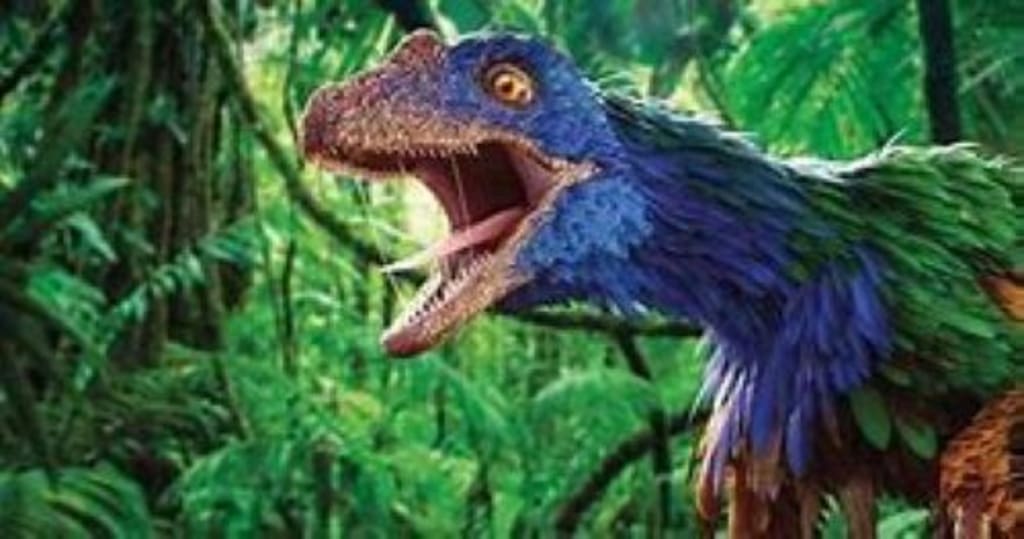Brontosaurus Isn't A Real Dinosaur
And Other Dinosaur Misconceptions

Almost everybody has loved dinosaurs at some point. Some, like me, have never "grown out" of our obsession with these prehistoric beasts. As such, we have a healthy love of them even when times are tough. it is the mystery, the absolute greatness of them that I have come to respect. As such, I have accumulated 34 years of dinosaur trivia to astound your friends with!
1. Brontosaurus is really a dinosaur
Everybody has that little brother, niece or family friend that has to share their knowledge about this dinosaur with you every chance they get. It get's so tiring to hear the same fact over and over. Well, here is something you can shove back at their snotty faces.
The trouble began in 1879, with a conflict called the Bone Wars. Edward Drinker Cope and Othniel Charles Marsh were competing paleontologists who despised one another. They got into an unofficial competition to see which paleontologist could name the most dinosaurs.
Marsh found a massive skeleton in the Morrison formation, the biggest dinosaur yet found. It was missing a few things, like the feet, portions of the tail and the skull, but was otherwise able to be mounted. Marsh "filled in" the skeleton with casts and imagined parts from another long-necked sauropod dinosaur, Camarasaurus.
This created an incorrect composite dinosaur. However, Brontosaurus had already captured the imagination of the world. When in 1905 a paleontologist named Elmer Riggs published a paper saying that Brontosaurus and another sauropod named Apatosaurus were too closely related to be considered separate. Since Apatosaurus was discovered first, it took over the name for all the specimens.
Even though the scientists had changed their minds, popular culture was not so easily swayed. Brontosaurus was featured in one of the first animated films, Gertie the Dinosaur in 1914 as well as the silent movie The Lost World in 1925. Despite paleontologist's best efforts, the name Brontosaurus stuck.
In 2015, another look at the skeletons determined that even though they were very similar, there were enough differences to validate the resurrection of the Brontosaurus name alongside Apatosaurus. Brontosaurus lives again! Take that five year old kids!
2. Jurassic Park Was Pretty Wrong
Even though the film from 1993 was for the longest time the most accurate portrayal of dinosaurs in film, time has taken it's toll on that accuracy. Some errors were even intentional to make the dinosaurs scarier and the movie more exciting.
The first fact almost everybody knows, the raptors in the movie were not Velociraptor, but were instead based on Deinonychus or Utahraptor. As Velociraptor is way more of a bad ass name, they used that one instead. Imagine kids trying to sound out the name Deinonychus (die-non-ik-us)!
Most of the dinosaurs should have been feathered. The raptors and Tyrannosaurus especially would have had feathers. This has been accepted as fact for around 20 years now that birds are a variant of feathered dinosaur. As most audiences would not have accepted feathered dinosaurs, the sequel movies continued with the 1990's science.
Tyrannosaurus could not have caught the Jeep it was chasing. The movie states that ole Rexy could run about 32 miles an hour, but new analysis of it's bones have said it's foot bones would have shattered with it's 7 ton bulk if it did. Instead, Tyrannosaurus likely was a long distance walker, reaching a top speed of about 12 to 17 miles per hour for most estimates.
You cannot cross a frog and a dinosaur and get only a slightly modified animal. Even though most animals share around 80% of their DNA, you cannot splice other animals in so easily. The scientists at Jurassic World would have gotten monsters like the fictional Indominus Rex far more often. Or some kind of Frogasaurus.
The film's main villains, the raptors, were also likely not fast. Raptor dinosaur skeletons seem to be mostly designed for pouncing and ambushing rather than long distance running. The exceptions appear to be the actual dinosaur Velociraptor and the newly discovered Dakotaraptor.
Don't let these inaccuracies diminish the movie fun though!
3. Tyrannosaurus Was Either a Scavenger or a Predator
This one got a bit heated. Some scientists in the early to mid 2000's decided that T-Rex was too slow and too dumb to catch living prey. Also the Tyrannosaur brain was overly devoted to it's nose, which would make smelling out rotting corpses from far away easier. They theorized that the Tyrant Lizard King could only munch on dead dinosaurs.
This kind of made sense at the time. Somebody had to eat all the meat on a 30 ton sauropod and Rex jaws often had infections from rotting meat. However, nature rarely lets her creations fall neatly into the boxes we try to put them in.
A new analysis of a Tyrannosaur brain concluded they were fairly intelligent (for a dinosaur). Also, the evidence of Tyrannosaur teeth embedded in Triceratops bone which had healed is almost conclusive. T-Rex was, at least some times, an active predator.
It is likely that Tyrannosaurus both hunted prey and ate dead dinosaurs that it found. Lions and hyenas do the same thing today, so why not Tyrannosaurus?
4. Humans Never Fought a T-Rex
This one has bad 70's movies to blame. Many people saw movies during that time that featured cave men fighting off ravenous dinosaurs and rescuing buxom cave ladies.
In reality, dinosaurs lived 65 million years ago. Humans have been around for less than one million. A lot less. There would not have even been remnants of dinosaurs around for humans to encounter.
In reality, the only way that we could actually see live dinosaurs is to go ack in time or recreate them. As scientists say that backwards time travel is all but impossible that leaves genetics. As we know we cannot find an intact dinosaur DNA strand, that would leave us modifying their closest living relatives, birds, to get something resembling a dinosaur. But instead of a T-Rex, we would get a Chickenasaurus, something new and created by us, not a true dinosaur.
There are fun ways to experience dinosaurs though. There is the classic of going to a museum and seeing mounted skeletons. I recommend the Los Angeles Natural History Museum with it's several Tyrannosaur Skeletons, Triceratops and Carnotaurus, it is a lesser known highlight to visitors to LA.
There are also traveling shows that feature animatronic dinosaurs and other ancient animals. These are sculpted by some amazing artists that showcase how an ancient animal may have looked and moved. Even in these COVID-19 times, you can still do drive through tours.
As such, dinosaurs and man will only meet in our imaginations
5. Those Aren't Dinosaurs!
Nothing used to make me more upset than when people used to refer to swimming or flying dinosaurs. Just because an animal is old, does not mean it is a dinosaur. There were other ancient reptiles and mammals that lived long ago and were just as fascinating as dinosaurs.
The "swimming" dinosaurs were actually ancient reptiles more closely related to lizards. Mosasaurs, Plesiosaurs, Icthyosaurs and giant sea turtles all ruled the ancient seas. An ancient reptile that looked like a massive dolphin, Shastasaurus, was likely the largest sea animal to live besides the blue whale at a whopping 8o feet long!
Pterosaurs were the first vertebrates to take to the sky and were some of the most successful animals to ever live. Some of the giant ones like Quetzalcoatlus (ket-zal-ko-at-lus) had wingspans of up to 36 feet, or the size of a private airplane and was as tall as a giraffe! There is even the six foot skull of a Pteranodon on display at the LA Museum of Natural history. They were not dinosaurs, but were closely related.
Dimetrodon is one of the other animals to be considered a dinosaur. It was actually a pelycosaur, more closely related to early mammals than reptiles based on it's teeth and sail on it's back. Mammals have different shaped teeth, where reptiles had only one style of teeth. Dimetrodon even means, "two-sized teeth". There were sail backed dinosaurs like Spinosaurus and Concavenator, so fans of the sail will not miss out when looking for dinosaurs.
Some people also like to lump ancient mammals in with dinosaurs, like the woolly mammoth and saber-toothed cat. These fabulous mammals came much later after dinosaurs and even fought our ancestors for control of this world.
Dinosaurs specifically are land animals that share similar bone structure. Hollow bones, legs that bear weight directly beneath them and holes in their skulls all point at common origin. So surprise your friends the next time they say they love "flying dinosaurs" by hitting them with some knowledge!
6. Most Dinosaur Bones Are Not Bone At All
This one blew my mind when I was 12. It is true that sometimes paleontologists will find actual bits of bone and DNA, but it is very rare for such material to survive.
Instead, the vast majority of bones we find are formed from fossilization and actually rock. The process begins when an animal dies in water, sand or mud and is quickly covered. The material around the animal hardens as the soft organs and skin rot away, leaving just the skeleton.
This new rock makes a cast around the bones, an imprint. As the bones finally begin to decay, water carries small bits of sediment into the cast and makes a copy of the dinosaur bone! This then hardens into rock and we find it millions of years later!
As this process is very tricky, some bones are not preserved. This, along with predators scattering the bones, leaves incomplete skeletons for scientists to puzzle over.
7. Would You Like to Know More?
There are some awesome resources out there for learning more about dinosaurs. Books, movies, TV shows, museums, traveling shows and video games all allow us to experience them in all their ancient glory.
As far as books go, you cannot go wrong with Jurassic Park and The Lost World by Michael Chrichton. They are a little outdated, but feature fascinating glimpses into dinosaur behavior in a fast paced setting. I also recommend Raptor Red by Bob Bakker. It is an intimate portrait of a Utahraptor and all the other plants and animals that lived in it. It too is a little outdated, but definitely worth a read.
For movies we again feature Jurassic Park and all it's sequels. It may have gotten some facts wrong, but still features some of the most life-like portrayals of dinosaurs out there. I also want to feature the movie Dinosaur by Disney. It feature gorgeous landscapes, extraordinarily good CGI dinosaurs and fairly accurate depictions. Just ignore the story though. It involved lemurs, meteors and befriending an Iguanodon.
For TV shows, there is no better one than BBC's Walking With Dinosaurs. It is some of the most accurate information available at the time, but is also starting to show it's age. It spawned several spin offs, like Walking With Prehistoric Beasts, Walking With Cavemen and Big Al, A Walking With Dinosaurs Special as well as a movie of the same title (the movie is not very good in my opinion). All are worth a watch, but few are as fun and enthralling as the original.
For museums, I have already mentioned the superb LA Museum of natural History. It is relatively cheap, very entertaining and one of the highlights of my honeymoon! I also recommend Dinosaur National Monument in Utah. It features hundreds of dinosaurs stuck in a hillside. A bunker protects visitors and the fossils from the sun and elements. It is not to be missed! Lastly, the American Museum of Natural History in Central Park New York is one of the oldest institutions featuring dinosaurs, including the original T-Rex discovery!
Traveling shows and theme parks also feature dinosaurs. I highly recommend Jurassic Quest, especially for youngsters as it features life sized replicas of dinosaurs and other ancient animals as moving animatronics. Universal Theme Parks also feature a Jurassic Park ride, dinosaur experiences as well as dinosaur merchandise. The Animal Kingdom in Disney World Orlando also features many dinosaur attractions. In addition to rides, mock excavations and themed food, you can also glimpse a copy of Sue, one of the largest and most complete T-Rex fossils ever found!
Dinosaurs tell us so much about where we have been as far as life on this planet is concerned. That in turn helps us see where we are going. I hope you are able to sock some knowledge into other people with this and have expanded your own brain too!
About the Creator
Enjoyed the story? Support the Creator.
Subscribe for free to receive all their stories in your feed. You could also pledge your support or give them a one-off tip, letting them know you appreciate their work.
Reader insights
Nice work
Very well written. Keep up the good work!
Top insights
Compelling and original writing
Creative use of language & vocab
Easy to read and follow
Well-structured & engaging content
Excellent storytelling
Original narrative & well developed characters
Expert insights and opinions
Arguments were carefully researched and presented
Eye opening
Niche topic & fresh perspectives
Heartfelt and relatable
The story invoked strong personal emotions
On-point and relevant
Writing reflected the title & theme





Comments (1)
Very interesting. In college I was an Elementary Education major in the late 80's and it students in this major had to make a Dinosaur project for the science/social studies concept area. I did one for preschool. It was fun.